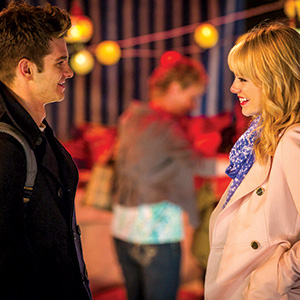

It’s futile to wait for the easter egg at the end of The Amazing Spider-Man 2—not just because there isn’t one, but also because the entire movie is an easter egg: setting up the hero and the antagonist for the sequel.
Anyway, the powers that be have opened the toy box. Oscorp’s basement is visited, as seen in the previews: there’s an untenanted tentacle-backpack for some future Doc Ock, and a pair of mechanical wings waiting for whichever British theatrical knight shaves his head to play The Vulture. (Paul Giamatti, as the surprise villain in the coda, went bald to perform dialogue that amounts to “Snarl! Arrrgh.”)
Instead of a celeb popup, I saw, among the last words in the end title crawl, in block letters, “BE MOVED.” I’m as used to the Corporate Imperative tense as anyone, but maybe this slogan (for some kind of do-gooder group?) would have helped at the beginning of the film, putting us in the proper frame of mind.
It’s a hard movie to unpack. Peter Parker (Andrew Garfield) is the cowled hero of NYC, but he lives humbly with his pesky aunt (Sally Fields, allowing a bit of clinginess to show). Parker is overbooked—this movie knows how he feels. He begins to learn that his parents were Silkwooded by the evil Oscorp; meanwhile he renews his friendship with the troubled young Osborn heir, Harry (Dane DeHaan; with his ice-colored eyes and a spray of Hitler hair over his forehead, he’s the film’s standout). Peter’s girlfriend Gwen Stacy (Emma Stone) is getting fed up with Peter’s inability to show up on time. Peter’s own feelings toward Gwen reveal a fragility that doesn’t show when he’s in costume. That’s when a monster made of electricity turns up to devastate the power grid.
The action sequences were thought out, anyway, expertly pre-vised and animated to turn Spider-Man every which way but inside-out. In the first fight, he’s catching a dozen vials of plutonium at once. Show me a second where Spider-Man does the old Buster Keaton stunt of grabbing the end of a passing vehicle and flying away, and I’m happy; the action sequences are never so busy that they’re unamusing. Still, Jamie Foxx’s characterization of Max Dillon, later Electro, isn’t much. Maybe it’s just hard to identify with the problem of getting dunked in a tank full of mutated electric eels on your birthday. Max is written as an underappreciated nerd; Foxx hammed it up with thick specs and a pocket protector as overstuffed as this plot. Rescued by Spider-Man, Max becomes obsessed with the hero, even before he has his fateful industrial accident. Meanwhile Spider-Man, too, becomes a stalker, following Gwen Stacy around during one of their breakups.
In 3D the background is a blur. It’s strange how little atmosphere this comic-opera film has, even in the moment where Electro is in Arkham-like asylum being electro-tortured by a German scientist called “Dr. Kafka.”
Peter Parker here is an emotional wreck, an orphan thrice over, if you count Uncle Ben; when unmasked, he’s frequently in tears. In the love scenes, director Marc Webb was likely hoping for something as off the cuff as the banter between Tony and Pepper in the Iron Man films. It doesn’t work: when Peter isn’t blocked, he’s babbling. Gwen’s contradictory characterization is revealed by a line you’ll never hear twice: “I got into Oxford! Woo hoo!”
There’s one spontaneous moment between the couple that works. Spider-Man leaps off to battle, and Stone’s Gwen yells, “Peter! …” and then claps her hand over her mouth to keep the already-fled secret from escaping. Despite the addition of a Dr. Girlfriend (“Felicia” played by Felicity Jones) for Osborn, the film’s real slowing down for romance is played between Peter and Harry, walking around a carousel, skipping stones by the water, and asking each other searching questions: “I try not to think about it.” “How’s that working out for you?” All this before the ultimate reveal that they, alas, can never be friends. (And then when Peter and Gwen finally kiss, it’s in a closet.)
PG-13 142 MIN.



